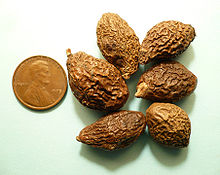Scaphium affine[1] is a tree species in the family Malvaceae, subfamily Sterculioideae (previously placed in the Sterculiaceae and synonyms include Sterculia lychnophora Hance[2]).The species is endemic to mainland Southeast Asia, and no subspecies are recognized in the Catalogue of Life.[3]
| Scaphium affine | |
|---|---|

| |
| Dried seeds for use in Vietnamese cuisine (known as hạt đười ươi) | |
| Scientific classification | |
| Kingdom: | Plantae |
| Clade: | Tracheophytes |
| Clade: | Angiosperms |
| Clade: | Eudicots |
| Clade: | Rosids |
| Order: | Malvales |
| Family: | Malvaceae |
| Genus: | Scaphium |
| Species: | S. affine
|
| Binomial name | |
| Scaphium affine | |
| Synonyms | |
|
Sterculia lychnophora Hance | |
Scaphium affine has culinary and traditional medicinal uses. In English, it is known as malva nut tree, or sometimes "Taiwan sweet gum tree", although these names also apply to the similar Scaphium macropodum (Vietnamese: ươi).
Description
editThe tree can grow up to 25–30 meters in height, and its seeds are the size of a fingertip, with a brown, coarse-textured skin.
Common names for the malva nut
edit- Lao: ໝາກຈອງ /mȁːk cɔːŋ/
- Chinese: 胖大海; pinyin: pàngdàhǎi; lit. 'fat ocean'
- Vietnamese: hạt lười ươi; đười ươi; hột lười ươi
- Khmer: សំរង, lit. '(មិនមែនសំរ៉ង) ឈ្មោះឈើមួយប្រភេទ ផ្លែទុំស្ងួត បើត្រាំទឹករីកស្គុយ សាច់ស្កាតៗ ប្រើលាយស្ករបរិភោគជាចំណីត្រជាក់' /sɑmraoŋ/.
- Marathi: निरंजन फळ Niranjan Phal /NiRṃJN PhL/ (IAST)
- Hindi: मालवा फल Malva Phal /MāLVā PhL/ (IAST)
- Thai: ลูกสำรอง, หมากจอง, พุงทะลาย
- Malay: Kembang Semangkuk
- Tamil: அதிராம்பட்டினம், தமிழ்நாடு, உம்மாசலிமா கொட்டை
Culinary and medicinal use of the nuts
editIn traditional medicine, especially Ayurveda and traditional Chinese medicine, the seeds of this species and its close relative, S. macropodum, are used to treat gastrointestinal disorders, to soothe the throat, and as a "coolant". As a result, it is a popular non-timber forest product in Laos, where it is the country's second-largest export crop after coffee. Sterculinine, a bio-active alkaloid, is found in this species.
Malva nuts in soups and desserts
editThe flesh surrounding the dried seeds swells to eight times its original volume when soaked in water, forming an irregularly shaped, reddish gelatinous mass. In Vietnam, Thailand, Laos, and Cambodia, the flesh of the fruit, after being soaked and the seed kernel removed, is mixed with sugar, ice, and basil seeds to make a refreshing drink. They are sometimes also used, along with other ingredients, in sweet, cool soups similar to the Chinese tong sui.[4]
In China, the seeds of this species are used to make a variety of herbal teas, in which they are mixed with other ingredients such as sugar, dates, hawthorn berries, licorice, chrysanthemum flowers, lilyturf roots, and jasmine tea. Such herbal teas are believed to reduce bodily "heat", balance bodily fluids, and improve overall health.[citation needed]
Malva nuts in traditional Chinese medicine
editAccording to Chinese medicine, the use of "Pang Da Hai" can remove heat from the lung, cure sore throats, counteract toxicity, and moisten the bowels. Specific symptoms treated include: hoarseness of voice, dry cough or productive cough with yellow sticky sputum, sore, dry throat due to heat in the lung and constipation with headache and bloodshot eyes. Consume malva nut by adding one or two nuts to a large cup of boiling water and consume the liquid. Typically, in traditional Chinese medicine, malva nut would be part of a larger formula of herbs designed to address a person's condition.
Although it possesses medicinal properties, care must be taken with its consumption. Avoid boiling more than 3 seeds per drink. Excessive consumption of this species can cause watery phlegm, nausea, coughing, and tongue swelling. People with frequent digestion problems and abdominal pain or diarrhea should avoid it entirely.
References
edit- ^ Pierre, 1889 In: Fl. For. Cochinch. Fasc. 13 (1889) sub t. 193-95, in text.
- ^ The Plant List Sterculia lychnophora Hance.
- ^ Roskov Y.; Kunze T.; Orrell T.; Abucay L.; Paglinawan L.; Culham A.; Bailly N.; Kirk P.; Bourgoin T.; Baillargeon G.; Decock W.; De Wever A. (2014). Didžiulis V. (ed.). "Species 2000 & ITIS Catalogue of Life: 2014 Annual Checklist". Species 2000: Reading, UK. Retrieved 26 May 2014.
- ^ "Webshots - Desktop Wallpaper / Screen Savers".
External links
edit- Media related to Scaphium affine at Wikimedia Commons
- Malva nut on the Lao NTFP wiki
- Detailed reference in the Lao NTFP network's "Tree tenure and forest management in Southern Laos" (pgs 4~14)